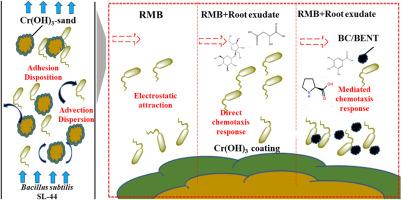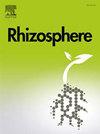根渗出物和载体介导的枯草芽孢杆菌 SL-44 在 Cr(OH)3 改性多孔介质中的运动
IF 3.4
3区 生物学
Q1 PLANT SCIENCES
引用次数: 0
摘要
植物生长促进根瘤菌(PGPR)对受铬污染的土壤有修复作用,但修复范围仅限于细菌周围的一小块区域。因此,修复效果取决于细菌在土壤中的迁移能力。根系渗出物通过降低枯草芽孢杆菌 SL-44 的粘附系数 katt 和水动力分散系数 D,增强了其趋化性和运动能力,运动能力提高了 7.84%-20.00%。在根渗出物中,脯氨酸和蔗糖能显著提高 SL44 的运动能力。生物炭和膨润土增加了 SL-44 的 Katt 和 D,抑制了细菌的运动,提高了在载体表面的滞留率。生物炭和膨润土分别减少了 57.99% 和 50.42% 的细菌运动。这些减少是由大孔隙造成的。SL-44 运动与环境根渗出物的浓度呈正相关(R2 = 0.88-0.92)。模拟土壤研究的结果通过 qPCR 在实际的农业铬污染土壤中得到了验证。本文章由计算机程序翻译,如有差异,请以英文原文为准。

Locomotion of Bacillus subtilis SL-44 mediated by root exudate and carrier in Cr(OH)3-modified porous media
Plant growth promoting rhizobacteria (PGPR) have a remediation effect on Cr-contaminated soil; however, the remediation scope is only within a small area around the bacteria. Hence, the remediation effect depends on the migration ability of bacteria in the soil. Root exudates enhance the chemotaxis and locomotion of Bacillus subtilis SL-44 by reducing its adhesion coefficient katt and hydrodynamic dispersion coefficient D. The locomotion capacity was enhanced by 7.84%–20.00%. Among the root exudates, proline and sucrose remarkably improved the motility of SL44. Biochar and bentonite increased the katt and D of SL-44, inhibited bacterial locomotion, and improved the retention rate on the carrier surface. Bacterial locomotion was reduced by biochar and bentonite by 57.99% and 50.42%, respectively. These reductions were caused by macropore. SL-44 locomotion was positively correlated with the concentration of environmental root exudate (R2 = 0.88−0.92). The results of the simulated soil study were validated in actual agricultural Cr-contaminated soils through qPCR.
求助全文
通过发布文献求助,成功后即可免费获取论文全文。
去求助
来源期刊

Rhizosphere
Agricultural and Biological Sciences-Agronomy and Crop Science
CiteScore
5.70
自引率
8.10%
发文量
155
审稿时长
29 days
期刊介绍:
Rhizosphere aims to advance the frontier of our understanding of plant-soil interactions. Rhizosphere is a multidisciplinary journal that publishes research on the interactions between plant roots, soil organisms, nutrients, and water. Except carbon fixation by photosynthesis, plants obtain all other elements primarily from soil through roots.
We are beginning to understand how communications at the rhizosphere, with soil organisms and other plant species, affect root exudates and nutrient uptake. This rapidly evolving subject utilizes molecular biology and genomic tools, food web or community structure manipulations, high performance liquid chromatography, isotopic analysis, diverse spectroscopic analytics, tomography and other microscopy, complex statistical and modeling tools.
 求助内容:
求助内容: 应助结果提醒方式:
应助结果提醒方式:


